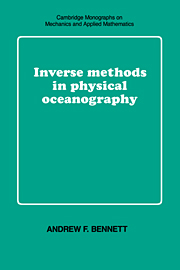Book contents
- Frontmatter
- Contents
- Preface
- 1 Finite-dimensional inverse theory
- 2 The smoothing of observations
- 3 Data assimilation
- 4 The spatial structure of the Kalman filter
- 5 Generalized inverses of dynamical models
- 6 Antenna analysis
- 7 Nonlinear quasi-geostrophic models
- 8 Open-ocean modelling: quasi-geostrophy
- 9 Primitive-equation models
- 10 Outstanding problems
- Bibliography
- Subject index
3 - Data assimilation
Published online by Cambridge University Press: 08 January 2010
- Frontmatter
- Contents
- Preface
- 1 Finite-dimensional inverse theory
- 2 The smoothing of observations
- 3 Data assimilation
- 4 The spatial structure of the Kalman filter
- 5 Generalized inverses of dynamical models
- 6 Antenna analysis
- 7 Nonlinear quasi-geostrophic models
- 8 Open-ocean modelling: quasi-geostrophy
- 9 Primitive-equation models
- 10 Outstanding problems
- Bibliography
- Subject index
Summary
Introduction
Most major ocean currents have dynamics which are significantly nonlinear. This precludes the ready development of inverse methods along the lines described in Chapter. Accordingly, most attempts to combine oceans models and measurements have followed the practice in operational meteorology: measurements are used to prepare initial conditions for the model, which is then integrated forward in time until further measurements are available. The model is thereupon re-initialized. Such a strategy may be described as sequential. It is clearly the only choice for prediction (that is, genuine forecasting in real time), but the relative simplicity of the approach has led to its adoption for smoothing as well. In the latter situation, measurements are available in some fixed interval, and a best estimate is required at each time t in the interval.
Sequential estimation techniques have become known to meteorologists and oceanographers as data assimilation. There has been extensive development of data-assimilation methods in meteorology, and it is fortunate for oceanographers in particular that the methods are now comprehensively described in the text by Daley (1991). The meteorological problem is especially difficult. First, the synoptic time scale in middle latitudes is only a few days; thus predictions of the synoptic scale must be prepared within a few hours of receipt of the measurements in order to be of any value. This creates great stress on the computing resource.
- Type
- Chapter
- Information
- Inverse Methods in Physical Oceanography , pp. 67 - 89Publisher: Cambridge University PressPrint publication year: 1992



